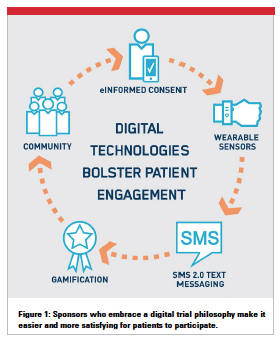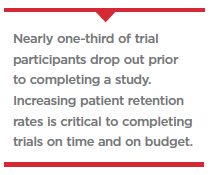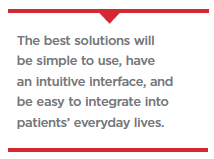 The opportunities to strengthen patient engagement across all phases of clinical development have never been greater. Today’s patients are savvy consumers of technology and they expect it to be both easy and enjoyable to use. Study sponsors and clinical research organizations (CROs) should take advantage of the latest tools to ensure that patients’ involvement meets their expectations
The opportunities to strengthen patient engagement across all phases of clinical development have never been greater. Today’s patients are savvy consumers of technology and they expect it to be both easy and enjoyable to use. Study sponsors and clinical research organizations (CROs) should take advantage of the latest tools to ensure that patients’ involvement meets their expectations  and fits into their daily lives, while complying with data privacy concerns in the way we collect, store, and transmit their data.
and fits into their daily lives, while complying with data privacy concerns in the way we collect, store, and transmit their data.
The Basics of Patient Engagement
On average, nearly one-third of trial participants drop out prior to completing a study.1 Thus, increasing patient retention rates is a critical success factor to completing trials on time and on budget. A sound approach to improving patient engagement includes:
Motivational and educational messaging. Patients require information on the protocol to understand the value of the study, and clear training on what they need to do throughout. Providing dynamic, on-device visual feedback and context-sensitive messaging including refreshers, FAQs, and videos will help ensure they are provided ongoing context about their participation.
Educational information/tips about their condition. One survey found that more than a quarter of trial participants are motivated by the promise of receiving information about their condition.2
Feedback on trial outcomes. Patients are also eager to know the outcome of  the trial or broader clinical program to which they have volunteered their time. In some therapy areas, this may require sponsors to maintain a relationship with patients over a number of years.
the trial or broader clinical program to which they have volunteered their time. In some therapy areas, this may require sponsors to maintain a relationship with patients over a number of years.
Feedback on the participant’s condition or participation. Most patients appreciate seeing graphical summaries of their symptom data so that they can see changes over time.
However, it may only be appropriate to share this information with patients at the end of a trial to prevent unintentional unblinding. Patients also like seeing a summary of their reporting compliance as compared to an average or target compliance —which can motivate them to stay on track in completing their diaries.
Messaging that acknowledges their contribution. A survey found that more than two-thirds (69%) of trial participants did so for “the opportunity to contribute to science."3 This selflessness should be supported with frequent communication, reinforcing that their participation is valued and worthwhile.
Digital Engagement Today
Sponsors and CROs who subscribe to a comprehensive digital trial philosophy will reap the benefits of making it easier and more satisfying for patients to participate (Figure 1). An effective digital strategy should emphasize:
Collecting more data directly from patients
Increasing dialog with patients throughout the study
Automating workflows for easier navigation across touchpoints
Leveraging artificial intelligence (AI) and data science to make participation easier.
Fortunately, advances in digital technology have opened new avenues for collecting data less obtrusively from within the context of a patient’s own  environment, as well as for supporting patients throughout the trial. The bring-your-own-device (BYOD) approach to electronic clinical outcome assessment (eCOA) lets patients use their device of choice to provide data and receive trial information. It’s well established that patients prefer digital over paper, and when they can use their own devices, data collection fits more easily into their daily lives.
environment, as well as for supporting patients throughout the trial. The bring-your-own-device (BYOD) approach to electronic clinical outcome assessment (eCOA) lets patients use their device of choice to provide data and receive trial information. It’s well established that patients prefer digital over paper, and when they can use their own devices, data collection fits more easily into their daily lives.
Patient Engagement Bolstered by Technology
Today, patient engagement is bolstered through such approaches as:
eConsent. Informing potential trial participants of trial rights and the expectations that will be made of them can easily be overwhelming for patients. Incorporating eConsent tools that take advantage of multimedia and do not necessarily involve a trial site visit can increase their understanding of why their ongoing participation is important.
Wearable sensors. Wearable sensors/biomonitors, i.e., glucometers, activity meters, heart rate monitors, sleep monitors, and peak flow meters are already being used successfully to collect data on primary and secondary endpoints.
SMS 2.0 Text messaging. Text messaging has been used for some time to remind patients to take their medication, attend a scheduled visit, or complete their diary. The advent of SMS 2.0 allows for much richer content and can  now be used to provide education, instruction, and encouragement throughout the trial.
now be used to provide education, instruction, and encouragement throughout the trial.
Gamification. Components of digital gaming such as competition, task level progression, and reward programs can guide patients through the stages of a trial and motivate them to remain compliant. While this approach should not be reserved for pediatric populations, the elements of the game must be designed for the target patient demographics.
Community. Invited participants can join online communities to share their experiences, find support groups and healthcare professionals, and access tips and training.
All software should be designed specifically for the patient population, appropriate for the protocol, and compliant with regulations. For this reason, proposed approaches should first be vetted with sample patients to ensure that the tools reduce, rather than add to, the patient’s participation burden. Once a technology is selected, it should be used in a small sub-study as a pilot before it is widely adopted across a clinical program.
The best solutions will be simple to use, have an intuitive interface, and be easy to integrate into patients’ everyday lives.
Coming Innovations
We foresee the growing use of multiple sensors and Internet-connected devices for “never-off" data capture. These technologies that fit into patients’ daily lives will reduce burden and increase their participation and retention.
The following innovations are largely experimental at the moment, but show great promise:
Voice Assistance (VA) technology. Conversational interfaces, such as Amazon’s Alexa are becoming ubiquitous in consumers’ lives. Since it’s predicted that by 2020 half of all online searches will be voice activated,4 this technology will be a game changer for the industry.
For example, a VA that has been interacting with a patient all day could announce, “It’s time to record your blood pressure." Thus prompted, the patient would take their reading and read out the results to the VA, which would automatically transmit the results to the trial’s electronic data capture (EDC) system.
Since VA technology enables hands-free it data entry, it can expand the pool of patients to include those with manual dexterity problems (i.e., arthritis, Parkinson’s disease). If using traditional paper or electronic devices, these patients might otherwise have difficulty entering data or fail to enter their responses regularly, eventually becoming non-compliant or entirely disengaged with the study.
The next generation of sensors. Sensors are opening up new possibilities for collecting objective data from patients beyond heart-rate monitors, pulse oximeters, and activity monitors. The world of possibilities includes:
Bio-patches revealing detailed muscle capabilities
Sensors in clothing to provide respiratory, cardiac, and perspiration data
xShoe inserts to track gait and steps
Jewelry that provides sleep data
Pill sensors
In-home sensors that record how often patients perform certain activities
Objective data gathered from sensors can confirm patient-reported outcomes data, or give it meaningful context. For example, entries in an electronic patient diary might explain an incidence of elevated heart rate picked up by a monitor.
Today’s clinical trial participants have different expectations from those of even a decade ago, including that technology will simplify and enhance their trial participation. When sponsors and CROs deliver on these expectations, they can reap the benefits of keeping patients better engaged, which goes a long way toward completing trials on time and on budget.(PV)
Editor’s Notes:
1 http://www.amazon.com/Global-Clinical-Trials-Alzheimers-Disease/dp/0124114644
2 http://www.ciscrp.org/wp-content/uploads/2014/01/2013-CISCRP-Study-Participants-Experiences.pdf
3 Stempel, Dan, “New Survey Highlights Need for Better Patient Engagement in Clinical Trials," MD Connect, June 14, 2017.
4 Olson, Christ, “Just say it: The future of search is voice and personal digital assistants," April 25, 2016. Accessed at https://www.campaignlive.co.uk/article/just-say-it-future-search-voice-personal-digital-assistants/1392459
ERT Inc. is a global data and technology company that minimizes risk and uncertainty in clinical trials, so that companies can move ahead quickly — and with confidence.
For more information, visit ert.com.


















